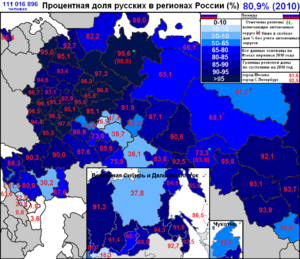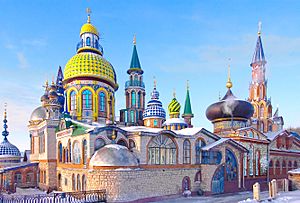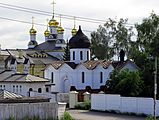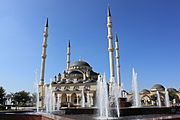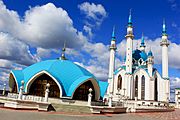Demographics of Russia facts for kids
The Demographics of Russia is all about studying the people who live in Russia and how their population changes.
In 2018, Russia had about 144,526,636 people. This number does not include people living in Crimea. This makes Russia the 9th most populated country in the world.
Contents
Who Lives in Russia? (Ethnic Groups)
An ethnic group is a group of people who share a common culture, language, or history. In Russia, most people are ethnic Russians, making up about 81% of the population.
Many other ethnic groups also live in Russia. The table below shows some of the largest groups and how their numbers changed between 2002 and 2010.
| Group | Language family | 2002 census | 2010 census | ||
|---|---|---|---|---|---|
| # | % | # | % | ||
| Russians | Indo-European | 115,889,107 | 80.6% | 111,016,896 | 80.9% |
| Tatars | Turkic | 5,554,601 | 3.9% | 5,310,649 | 3.9% |
| Ukrainians | Indo-European | 2,942,961 | 2.0% | 1,927,888 | 1.4% |
| Bashkirs | Turkic | 1,673,389 | 1.2% | 1,584,554 | 1.2% |
| Chuvashs | Turkic | 1,637,094 | 1.1% | 1,435,872 | 1.1% |
| Chechens | Northeast Caucasian | 1,360,253 | 1.0% | 1,431,360 | 1.0% |
| Armenians | Indo-European | 1,132,033 | 0.8% | 1,182,388 | 0.9% |
| Avars | Northeast Caucasian | 814,473 | 0.6% | 912,090 | 0.7% |
| Mordvins | Uralic | 843,350 | 0.6% | 744,237 | 0.5% |
| Kazakhs | Turkic | 653,962 | 0.5% | 647,732 | 0.5% |
| Azerbaijanis | Turkic | 621,840 | 0.4% | 603,070 | 0.4% |
| Dargins | Northeast Caucasian | 510,156 | 0.4% | 589,386 | 0.4% |
| Udmurts | Uralic | 636,906 | 0.5% | 552,299 | 0.4% |
| Mari | Uralic | 604,298 | 0.4% | 547,605 | 0.4% |
| Ossetians | Indo-European | 514,875 | 0.4% | 528,515 | 0.4% |
| Belarusians | Indo-European | 807,970 | 0.6% | 521,443 | 0.4% |
| Kabardins | Northwest Caucasian | 519,958 | 0.4% | 516,826 | 0.4% |
| Kumyks | Turkic | 422,409 | 0.3% | 503,060 | 0.4% |
| Sakha | Turkic | 443,852 | 0.3% | 478,085 | 0.4% |
| Lezgians | Northeast Caucasian | 411,535 | 0.3% | 473,722 | 0.3% |
How Many Children Are Born? (Fertility Rates)
The total fertility rate (TFR) is a way to measure how many children the average woman in a region is expected to have in her lifetime. In Russia, the TFR was 1.62 children per woman in 2017. This is one of the higher rates in Eastern Europe.
Fertility Rates by Region
The TFR can be very different depending on the region. For example, the lowest TFR is in Leningrad Oblast, while the highest is in the Republic of Tuva.
| Federal subject | 2017 TFR |
|---|---|
| Altai Krai | 1.64 |
| Amur Oblast | 1.71 |
| Arkhangelsk Oblast | 1.68 |
| Astrakhan Oblast | 1.73 |
| Belgorod Oblast | 1.39 |
| Bryansk Oblast | 1.43 |
| Chelyabinsk Oblast | 1.61 |
| Chukotka Autonomous Okrug | 2.08 |
| Chuvash Republic | 1.65 |
| Irkutsk Oblast | 1.86 |
| Ivanovo Oblast | 1.46 |
| Jewish Autonomous Oblast | 1.81 |
| Kabardino-Balkaria Republic | 1.61 |
| Kaliningrad Oblast | 1.57 |
| Kaluga Oblast | 1.64 |
| Kamchatka Krai | 1.78 |
| Karachay–Cherkess Republic | 1.43 |
| Kemerovo Oblast | 1.54 |
| Khabarovsk Krai | 1.64 |
| Khanty-Mansi Autonomous Okrug | 1.88 |
| Kirov Oblast | 1.70 |
| Kostroma Oblast | 1.70 |
| Krasnodar Krai | 1.72 |
| Krasnoyarsk Krai | 1.67 |
| Kurgan Oblast | 1.88 |
| Kursk Oblast | 1.46 |
| Leningrad Oblast | 1.22 |
| Lipetsk Oblast | 1.54 |
| Magadan Oblast | 1.60 |
| Moscow | 1.38 |
| Moscow Oblast | 1.61 |
| Murmansk Oblast | 1.56 |
| Nenets Autonomous Okrug | 2.35 |
| Nizhny Novgorod Oblast | 1.50 |
| Novgorod Oblast | 1.61 |
| Novosibirsk Oblast | 1.67 |
| Omsk Oblast | 1.61 |
| Orenburg Oblast | 1.73 |
| Oryol Oblast | 1.42 |
| Penza Oblast | 1.36 |
| Perm Krai | 1.75 |
| Primorski Krai | 1.60 |
| Pskov Oblast | 1.57 |
| Republic of Adygea | 1.52 |
| Republic of Altai | 2.36 |
| Republic of Bashkortostan | 1.70 |
| Republic of Buryatia | 2.00 |
| Republic of Chechnya | 2.73 |
| Republic of Crimea | 1.64 |
| Republic of Dagestan | 1.91 |
| Republic of Ingushetia | 1.77 |
| Republic of Kalmykia | 1.54 |
| Republic of Karelia | 1.56 |
| Republic of Khakassia | 1.78 |
| Republic of Komi | 1.78 |
| Republic of Mari El | 1.75 |
| Republic of Mordovia | 1.26 |
| Republic of North Ossetia–Alania | 1.75 |
| Republic of Sakha | 1.93 |
| Republic of Tatarstan | 1.65 |
| Republic of Tuva | 3.19 |
| Rostov Oblast | 1.46 |
| Ryazan Oblast | 1.51 |
| Sakhalin Oblast | 2.03 |
| Samara Oblast | 1.53 |
| Saratov Oblast | 1.39 |
| Sevastopol | 1.56 |
| Smolensk Oblast | 1.37 |
| St Petersburg | 1.50 |
| Stavropol Krai | 1.54 |
| Sverdlovsk Oblast | 1.76 |
| Tambov Oblast | 1.38 |
| Tomsk Oblast | 1.47 |
| Tula Oblast | 1.40 |
| Tver Oblast | 1.56 |
| Tyumen Oblast | 1.88 |
| Udmurt Republic | 1.72 |
| Ulyanovsk Oblast | 1.52 |
| Vladimir Oblast | 1.52 |
| Volgograd Oblast | 1.44 |
| Vologda Oblast | 1.70 |
| Voronezh Oblast | 1.37 |
| Yamalo-Nenets Autonomous Okrug | 1.95 |
| Yaroslavl Oblast | 1.53 |
| Zabaykalsky Krai | 1.87 |
What Religions Do People Follow?
Many different religions are practiced in Russia. The Temple of All Religions in Kazan is a symbol of this diversity. It is not an active church, but it shows how many different faiths exist there.
Christianity in Russia
In 2012, almost half of the people in Russia (47%) said they were Christians. Most Christians in Russia belong to the Russian Orthodox Church. About 61 million people, or 43% of the population, are Russian Orthodox Christians. Most of them live in Western Russia.
There are also about 400,000 Old Believers in Russia. This group makes up less than 1% of the population.
More Russians have been joining the Catholic faith recently. Catholics make up less than 1% of the population, with about 140,000 people. Many live in Western Russia. About half of Russian Catholics are ethnic Russians. Others include Germans, Armenians, Belarusians, Koreans, Poles, and Lithuanians.
Lutherans in Russia were traditionally ethnic Finns or Germans. Now, more Russians are becoming Lutherans. Some churches that used to be mostly Finnish now have more Russian members.
About 4% of the population are Christians who are not part of any specific church or group.
In April 2017, the Supreme Court of Russia decided that the activities of Jehovah's Witnesses were not allowed. Their activities are now banned in Russia. In the mid-2000s, there were around 255,000 Jehovah's Witnesses.
-
Catholic Church in Tobolsk.
Islam in Russia
Islam is the second largest religion in Russia. It is very common in the Caucasus region and in some republics in central Russia. In 2012, almost 7% of the population were Muslims. This number does not include the Muslim-majority regions of Chechnya and Ingushetia. The number of Muslims in Russia grew from 5.9 million to 11.4 million between 1998 and 2007.
Most Muslims in Russia follow Sunni teachings. A smaller group, just over 10%, follow Shia teachings. Sunni Sufism is a special tradition in some areas, especially in Chechnya and Dagestan.
Five regions in Russia have a majority Muslim population. These are Chechnya, Ingushetia, Dagestan, Kabardino-Balkaria, and Tatarstan.
Related Pages
Images for kids
-
Annunciation Cathedral in Voronezh
-
Moscow State University, a very important university in Russia.
-
Moscow, the capital and largest city of Russia.
-
Saint Petersburg, a cultural city and the second-largest.
-
Yekaterinburg, the fourth-largest city in the country.
See also
 In Spanish: Demografía de Rusia para niños
In Spanish: Demografía de Rusia para niños


